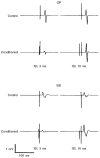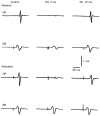Comparison of intracortical inhibition and facilitation in distal and proximal arm muscles in humans
- PMID: 9882759
- PMCID: PMC2269103
- DOI: 10.1111/j.1469-7793.1999.895ad.x
Comparison of intracortical inhibition and facilitation in distal and proximal arm muscles in humans
Abstract
1. Cortico-cortical inhibition and facilitation induced by paired transcranial magnetic stimulation (TMS) of the human motor cortex were investigated in the distal muscle opponens pollicis (OP) and the proximal muscle biceps brachii (BB) of normal subjects. 2. The test response evoked by TMS (125 % of motor threshold, MTh) in the relaxed OP and BB muscles was inhibited by a conditioning TMS (80 % of MTh) at short interstimulus intervals (ISIs; 2-5 ms) and facilitated at longer ISIs (10-25 ms). The test response was significantly less inhibited at short ISIs and more facilitated at long ISIs in the BB than OP. 3. The MTh at rest was significantly lower for the OP than for the BB, indicating a greater excitability of OP cortical area. However, the above pattern of inhibition and facilitation was preserved both when the stimulus intensity was adjusted to evoke test responses of matched size in the two muscles and within an ample range of conditioning stimulus intensities. 4. The use of a circular coil or a focal figure-of-eight coil produced no qualitative differences in the pattern of inhibition and facilitation in either muscle. 5. The significant difference in MTh between muscles was lost during voluntary activation. In both muscles, pre-innervation abolished the cortico-cortical facilitation and reduced the cortico-cortical inhibition. However, the latter remained larger in the OP than BB muscle. 6. We suggest that the different potency of intracortical inhibitory and facilitatory circuits directed towards distal and proximal arm muscles is related to their diverse prevalent functions.
Figures






 ) and BB (▪) muscles is plotted both for rest and active conditions. At rest (A; n = 7), significantly less inhibition and more facilitation was observed in the BB than in the OP muscle. In both muscles, voluntary activation (B; 5-10 % of maximum EMG activity; n = 5) clearly reduced the inhibition at an ISI of 3 ms (which remained significant only in the OP muscle) and abolished the facilitation at an ISI of 12 ms. A circular coil was used with a stimulus intensity evoking test MEPs of a matched size in the two muscles, while the conditioning stimulus was always 80 % of the MTh at rest (A) or during activation (B).
) and BB (▪) muscles is plotted both for rest and active conditions. At rest (A; n = 7), significantly less inhibition and more facilitation was observed in the BB than in the OP muscle. In both muscles, voluntary activation (B; 5-10 % of maximum EMG activity; n = 5) clearly reduced the inhibition at an ISI of 3 ms (which remained significant only in the OP muscle) and abolished the facilitation at an ISI of 12 ms. A circular coil was used with a stimulus intensity evoking test MEPs of a matched size in the two muscles, while the conditioning stimulus was always 80 % of the MTh at rest (A) or during activation (B).

References
-
- Abbruzzese G, Buccolieri A, Marchese R, Trompetto C, Mandich P, Schieppati M. Intracortical inhibition and facilitation are abnormal in Huntington's disease: a paired magnetic stimulation study. Neuroscience Letters. 1997;228:87–90. 10.1016/S0304-3940(97)00363-7. - DOI - PubMed
-
- Branston NM, Bentivoglio P, Momma F, Symon L. Changes in pyramidal tract conduction with experimental brain-stem ischaemia in the monkey. Electroencephalography and Clinical Neurophysiology. 1988;69:469–475. - PubMed
-
- Brown P, Ridding MC, Werhahn KJ, Rothwell JC, Marsden CD. Abnormalities of the balance between inhibition and excitation in the motor cortex of patients with cortical myoclonus. Brain. 1996;119:309–317. - PubMed
-
- Colebatch JG, Gandevia SC. The distribution of muscular weakness in upper motor neuron lesions affecting the arm. Brain. 1989;112:749–763. - PubMed
-
- Colebatch JG, Rothwell JC, Day BL, Thompson PD, Marsden CD. Cortical outflow to proximal arm muscles in man. Brain. 1990;113:1843–1856. - PubMed
Publication types
MeSH terms
LinkOut - more resources
Full Text Sources
Miscellaneous

